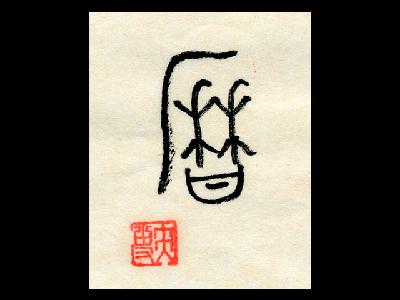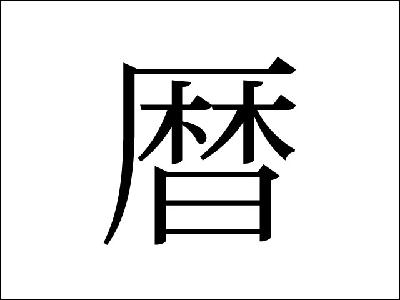【暦】 Reki, Koyomi Calendar
|
This character which came to have the meaning ‘koyomi: calendar’ shares its background with 歴, a character with the same origin. Both have a military background, showing an official commendation for meritorious deeds in war held below a 厂 precipice. Frequently, the final decisive battle was also the day of the termination of war. After victory, the individual merits of the soldiers were commended. This day became the memorial day of the end of war in calendars. All over the world, this way of thinking about memorial days seems to not have changed a lot since this origination of Kanji since 3000 years ago.
Places below precipices often were places for rituals. They were thought of as very strongly spiritual places. A gate was made with two 禾 marking trees below a precipice.
Although in other places the form taken is that of architecture made from stone, like in Europe, e.g. in Rome, the cities of the Roman Empire, later also the arc de triomphe in Paris, and with other triumphal arches, the custom of erecting military gates commemorating victory in war also can be seen in other parts of the world.
As this character is related to dating, the element 曰 below is likely to be misunderstood as representing that for 日 ‘sun, day.’ Here, however, as the military gate was made below the precipice and as this shows the communication with the gods, it shows 曰, read ‘etsu’ in Japanese, originally a receptacle for ‘norito,’ prayer writings to the gods.
Places below precipices often were places for rituals. They were thought of as very strongly spiritual places. A gate was made with two 禾 marking trees below a precipice.
Although in other places the form taken is that of architecture made from stone, like in Europe, e.g. in Rome, the cities of the Roman Empire, later also the arc de triomphe in Paris, and with other triumphal arches, the custom of erecting military gates commemorating victory in war also can be seen in other parts of the world.
As this character is related to dating, the element 曰 below is likely to be misunderstood as representing that for 日 ‘sun, day.’ Here, however, as the military gate was made below the precipice and as this shows the communication with the gods, it shows 曰, read ‘etsu’ in Japanese, originally a receptacle for ‘norito,’ prayer writings to the gods.
- name
- Editoral supervision: Dr. Christoph Schmitz, Researcher of Shirakawa Kanji Science, General and Japanese History of Philosophy and Thought
- hp
- http://nippon-kichi.jp/article_list.do?p=5332













